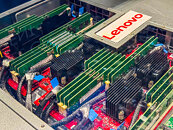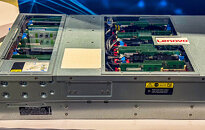- Joined
- Aug 19, 2017
- Messages
- 2,742 (1.01/day)
Expanding the system's computing capability with an additional accelerator like a GPU is common. However, expanding the system's memory capacity with room for more DIMM is something new. Thanks to ServeTheHome, we see that at the OCP Summit 2024, Lenovo showcased its ThinkSystem SR860 V3 server, leveraging CXL technology and Astera Labs Leo memory controllers to accommodate a staggering 16 TB of DDR5 memory across 128 DIMM slots. Traditional four-socket servers face limitations due to the memory channels supported by Intel Xeon processors. With each CPU supporting up to 16 DDR5 DIMMs, a four-socket configuration maxes out at 64 DIMMs, equating to 8 TB when using 128 GB RDIMMs. Lenovo's new approach expands this ceiling significantly by incorporating an additional 64 DIMM slots through CXL memory expansion.
The ThinkSystem SR860 V3 integrates Astera Labs Leo controllers to enable the CXL-connected DIMMs. These controllers manage up to four DDR5 DIMMs each, resulting in a layered memory design. The chassis base houses four Xeon processors, each linked to 16 directly connected DIMMs, while the upper section—called the "memory forest"—houses the additional CXL-enabled DIMMs. Beyond memory capabilities, the server supports up to four double-width GPUs, making it also a solution for high-performance computing and AI workloads. This design caters to scale-up applications requiring vast memory resources, such as large-scale database management, and allows the resources to stay in memory instead of waiting on storage. CXL-based memory architectures are expected to become more common next year. Future developments may see even larger systems with shared memory pools, enabling dynamic allocation across multiple servers. For more pictures and video walkthrough, check out ServeTheHome's post.


View at TechPowerUp Main Site | Source
The ThinkSystem SR860 V3 integrates Astera Labs Leo controllers to enable the CXL-connected DIMMs. These controllers manage up to four DDR5 DIMMs each, resulting in a layered memory design. The chassis base houses four Xeon processors, each linked to 16 directly connected DIMMs, while the upper section—called the "memory forest"—houses the additional CXL-enabled DIMMs. Beyond memory capabilities, the server supports up to four double-width GPUs, making it also a solution for high-performance computing and AI workloads. This design caters to scale-up applications requiring vast memory resources, such as large-scale database management, and allows the resources to stay in memory instead of waiting on storage. CXL-based memory architectures are expected to become more common next year. Future developments may see even larger systems with shared memory pools, enabling dynamic allocation across multiple servers. For more pictures and video walkthrough, check out ServeTheHome's post.


View at TechPowerUp Main Site | Source




